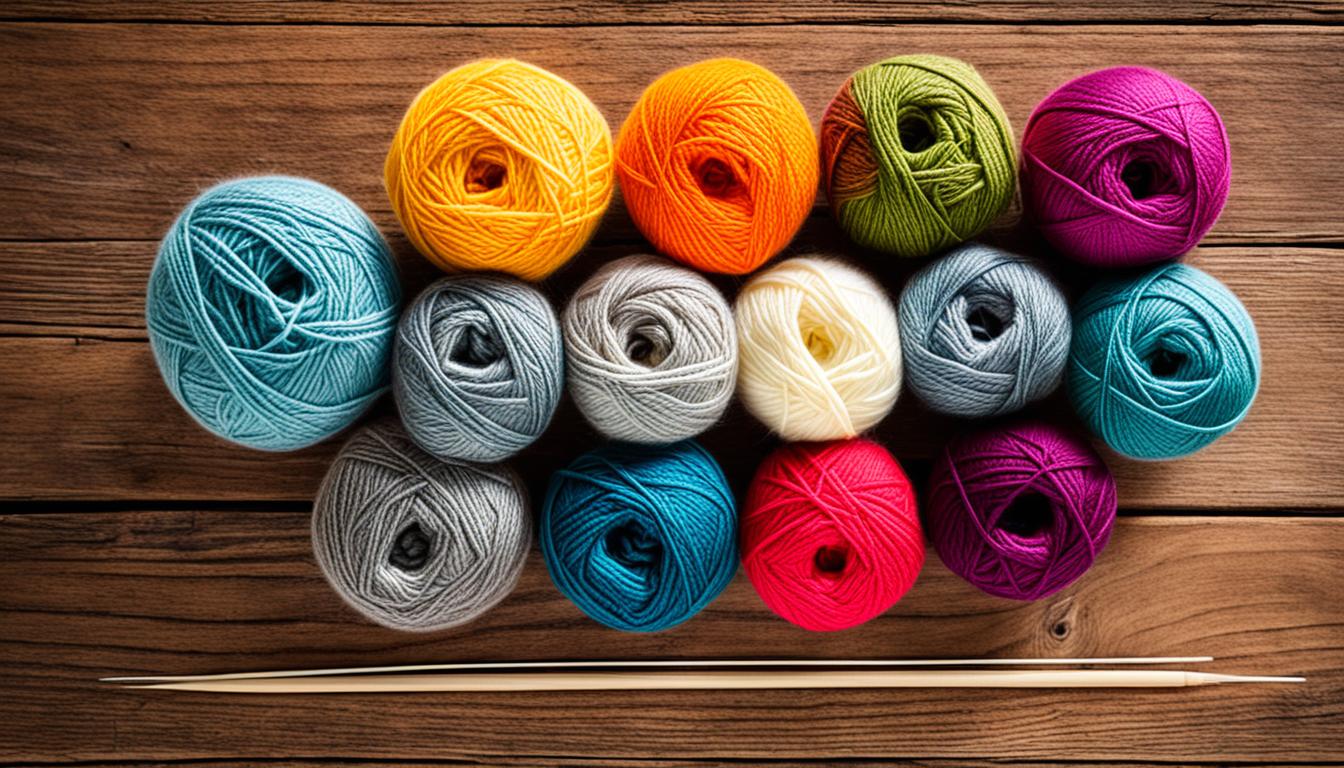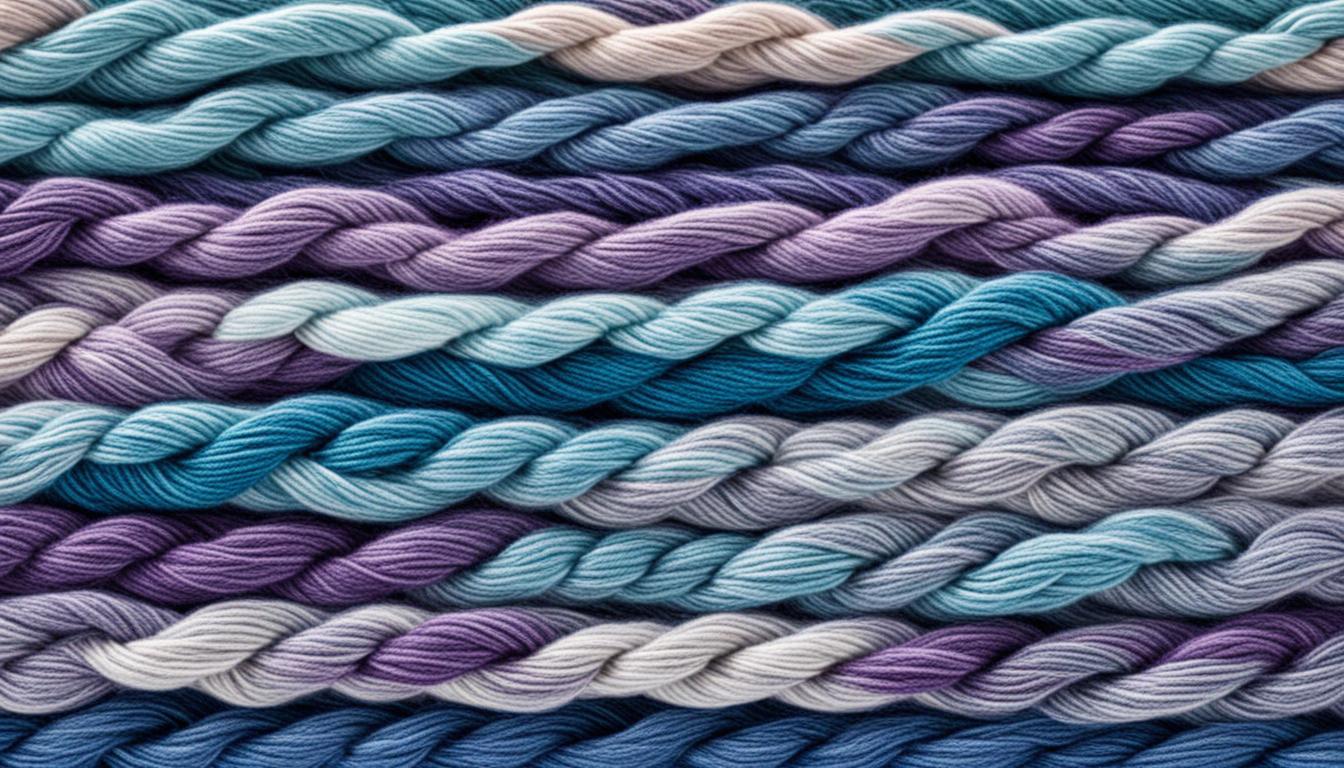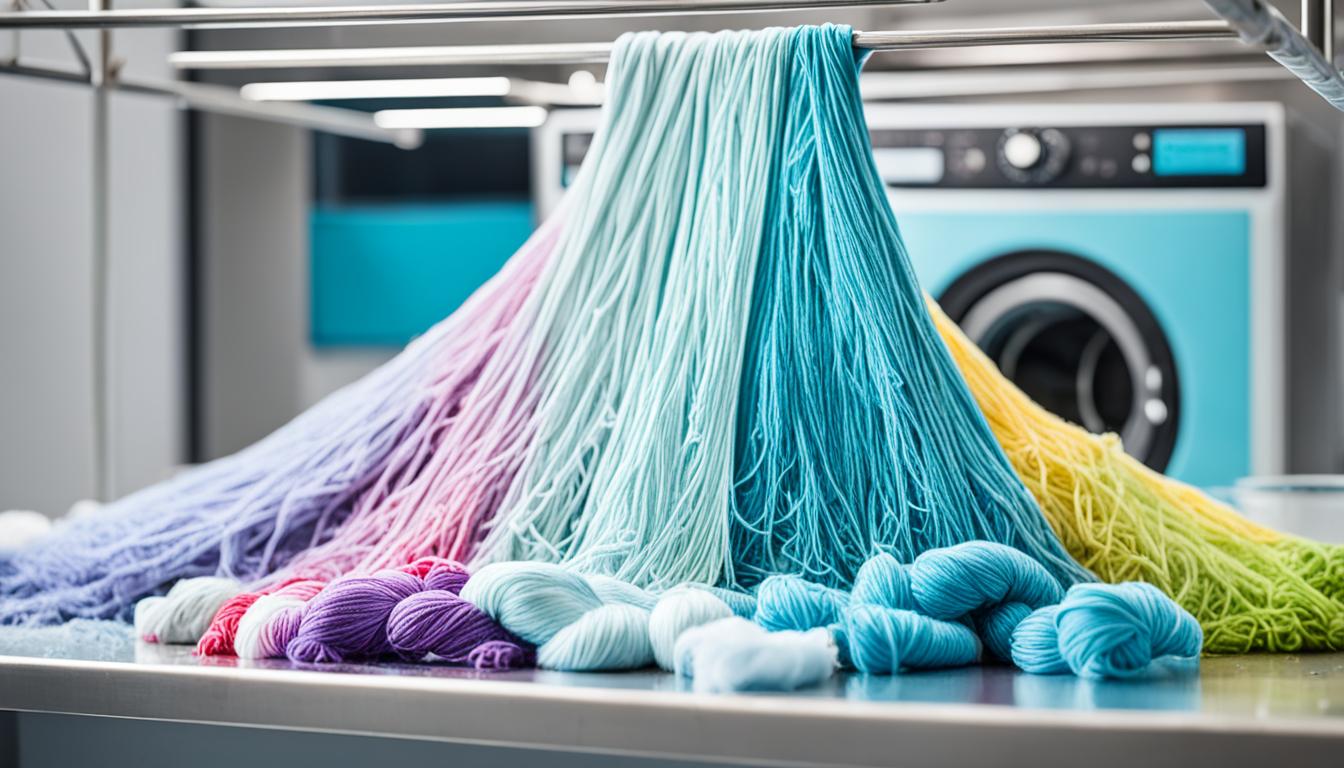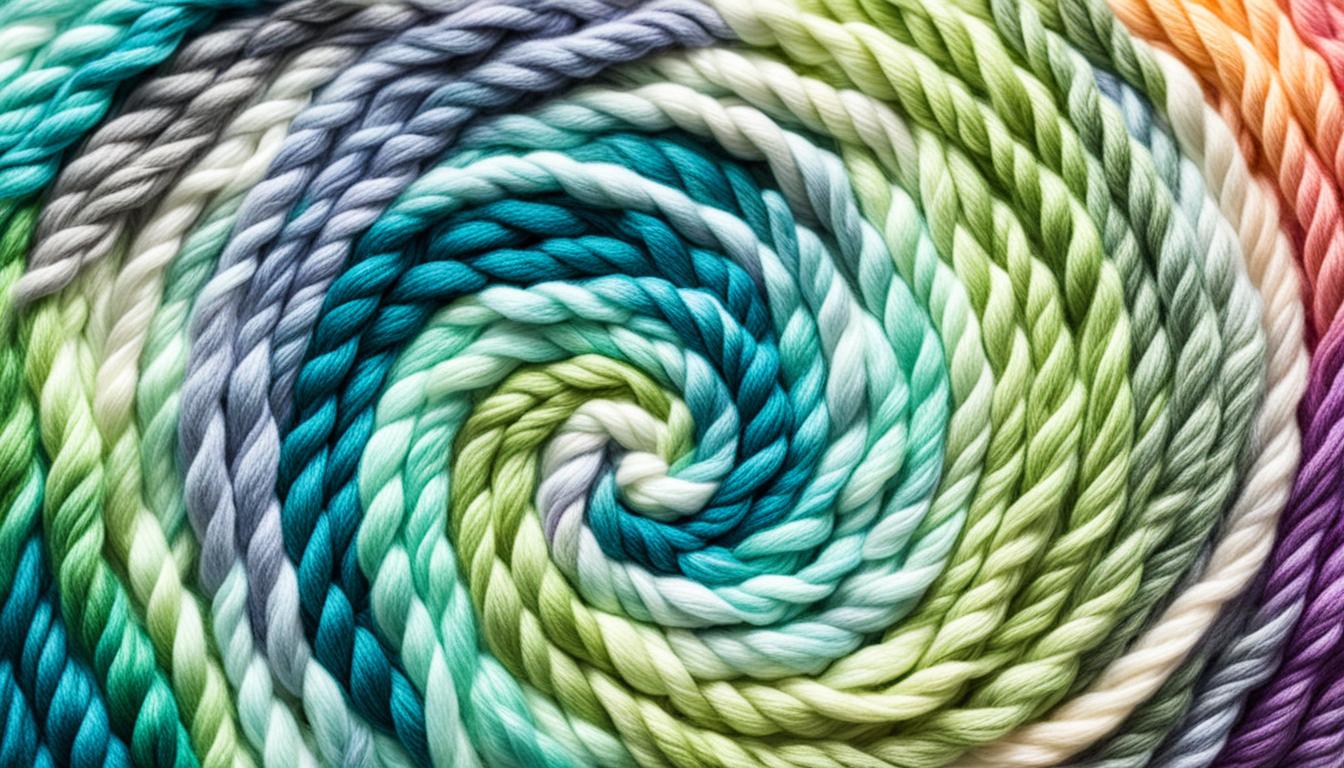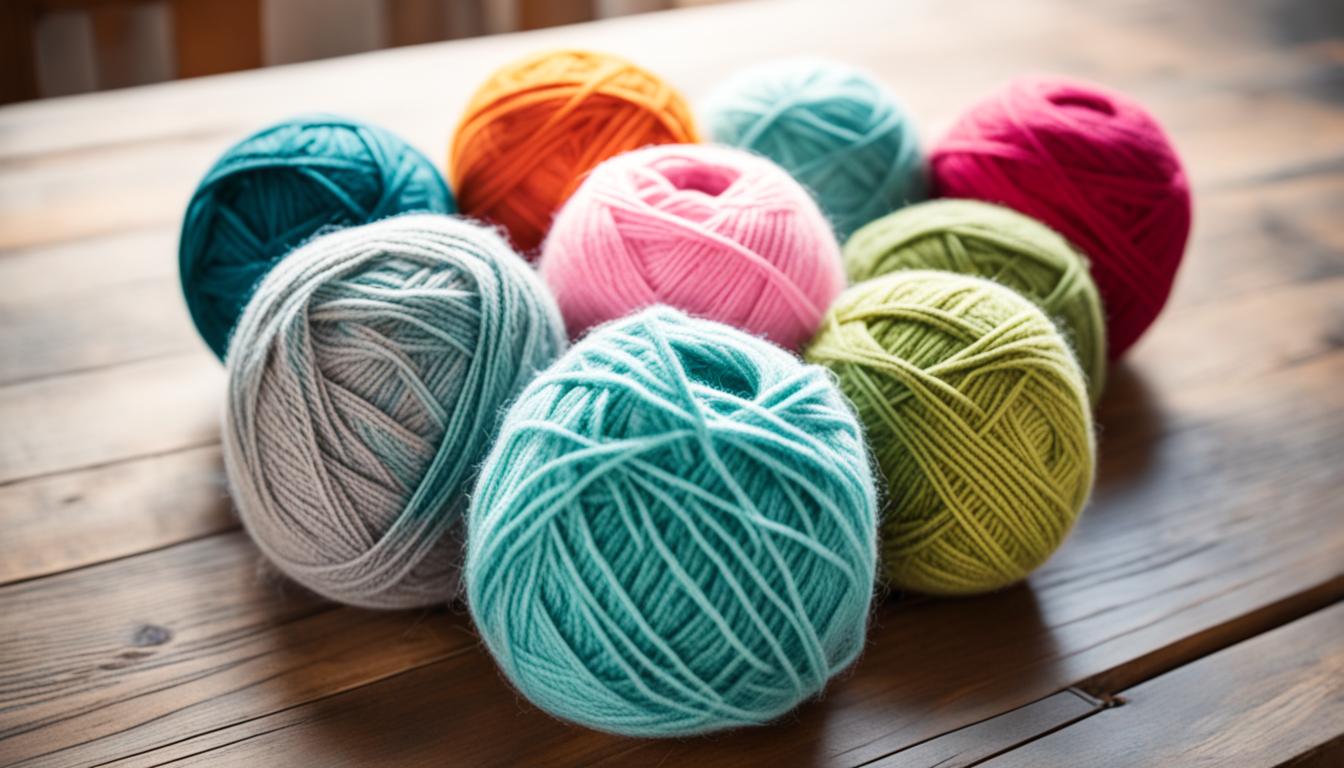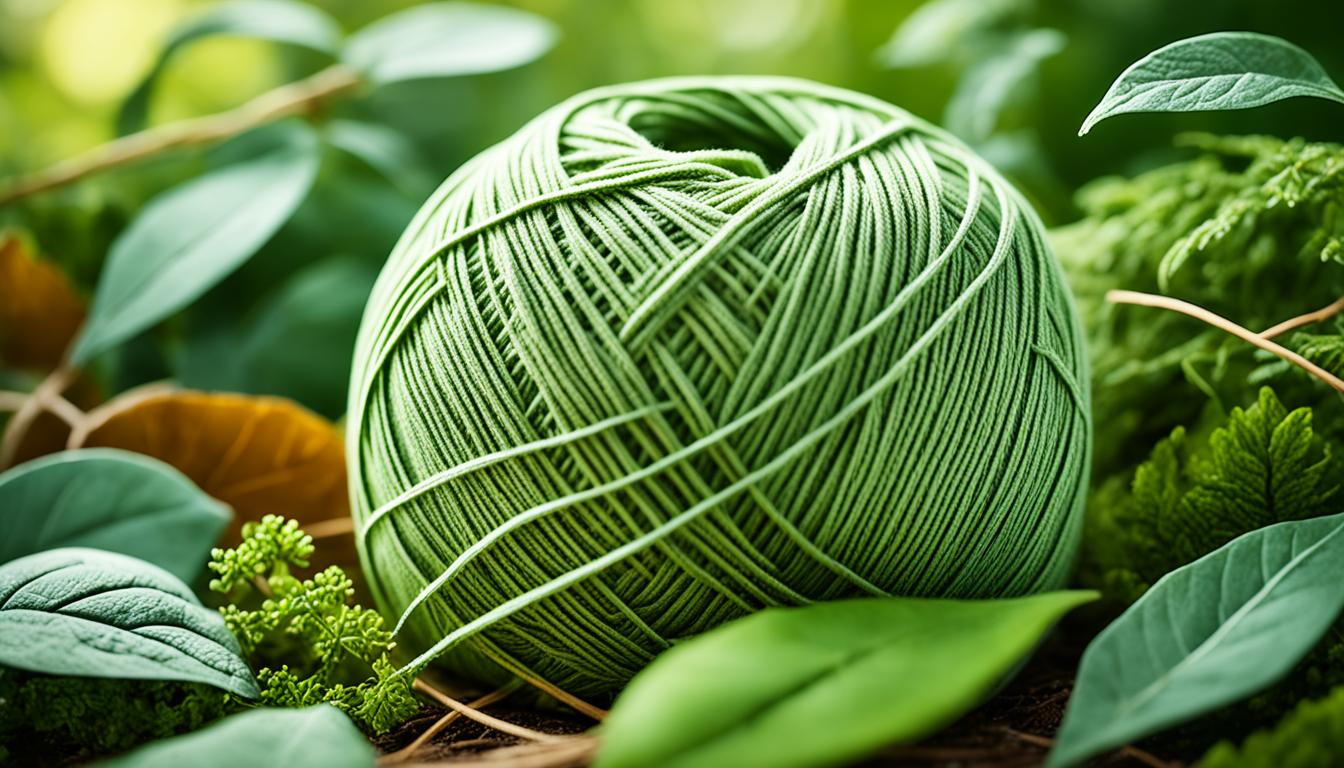Are you having a hard time selecting the ideal yarn for your needlepoint projects? With numerous choices out there, it can feel daunting to find the perfect one. But don’t worry! We’re here to assist you in navigating through the selection process and selecting the best yarn for your needlepoint creations. So, let’s delve into the realm of needlepoint yarn together.
Key Takeaways:
- Choosing the right yarn weight and thickness is crucial for a successful needlepoint project.
- Consider the yarn fiber and durability based on the project’s intended use.
- Popular needlepoint yarns include Persian yarn, tapestry yarn, crewel yarn, embroidery floss, pearl cotton, matte embroidery cotton, and metallic thread.
- Match the yarn to the type of canvas being used, such as mono canvas, double-thread canvas, interlock canvas, or plastic canvas.
- Texture, color, and personal preferences should also be taken into account when selecting needlepoint yarn.
Choosing the Right Yarn Weight and Thickness
In needlepoint, selecting the appropriate yarn weight and thickness is essential to achieve the desired results. The yarn chosen should align with the gauge of the needlepoint canvas, allowing for a smooth stitching experience and ensuring the final piece looks its best.
Yarn weight for needlepoint refers to the thickness of the yarn, which is typically categorized by numbers ranging from 0 to 7, with 0 being the thinnest and 7 being the thickest. Considering the yarn weight for needlepoint ensures that the yarn is compatible with the canvas and makes the stitching process easier.
The golden rule is that the lower the canvas gauge number, the heavier and thicker the yarn should be. For instance, if you’re working with a gauge 3 rug canvas, a very thick yarn is recommended. On the other hand, if you’re working with a gauge 26 silk gauze canvas, opt for ultra-fine silk thread.
The key is to choose a yarn that is thin enough to slip easily through the holes in the canvas without catching or fraying, yet thick enough to prevent the canvas threads from showing through the design. This ensures a clean and polished finished piece.
Yarn Weight vs. Recommended Canvas Gauge
| Yarn Weight | Recommended Canvas Gauge |
|---|---|
| Lace (0) | Gauge 28-30 |
| Fingering (1) | Gauge 24-26 |
| Sport (2) | Gauge 22-24 |
| DK (3) | Gauge 20-22 |
| Worsted (4) | Gauge 14-18 |
| Bulky (5) | Gauge 10-12 |
| Super Bulky (6) | Gauge 7-9 |
| Jumbo (7) | Gauge 2-6 |
By choosing the right yarn weight and thickness, you’ll ensure that the yarn complements the canvas, resulting in a beautifully stitched needlepoint project.
Selecting the Right Yarn Fiber and Durability
When it comes to needlepoint projects, selecting the right yarn fiber and ensuring durability are essential considerations. Different fibers offer unique characteristics that can impact the longevity and overall appearance of your needlepoint piece.
Exploring Yarn Fiber Options
Needlepoint yarns are made from a variety of fibers, each with its own advantages and properties. Wool, cotton, silk, acrylic, rayon, and metallic threads are commonly used in needlepoint projects.
- Wool: Wool is a popular choice for needlepoint due to its natural strength, wide range of colors, and durability. It is particularly suitable for projects that will receive heavy use, like chair seats or sofa cushions.
- Cotton: Cotton threads offer a smooth and soft texture, making them ideal for creating intricate designs. However, cotton may not be as durable as wool and is best suited for decorative needlepoint items.
- Silk: Silk threads add a touch of elegance to needlepoint projects with their luxurious feel. They are perfect for creating fine details and delicate designs, but may not be as durable as other fibers.
- Acrylic: Acrylic yarn is a synthetic alternative to natural fibers. It offers durability and a wide range of colors, making it a versatile choice for needlepoint projects.
- Rayon: Rayon threads have a shiny appearance and can add a touch of sophistication to decorative needlepoint pieces. However, they may not be as durable as wool or acrylic and are best suited for projects that won’t be regularly handled.
- Metallic: Metallic threads, such as gold or silver, can add sparkle and shine to your needlepoint projects. They are ideal for highlighting small areas or creating eye-catching accents.
By considering the fiber options and their specific qualities, you can select the yarn that best matches your project’s needs, ensuring both visual appeal and durability.
Ensuring Durability
When choosing yarn for needlepoint, durability is a key factor, especially for items that will undergo frequent use or handling. While wool is generally regarded as a durable option, other fibers may not withstand heavy wear and tear.
Avoid using knitting yarn for needlepoint projects that will receive substantial use, as it is typically less durable than yarn specifically designed for needlepoint.
For decorative needlepoint items that won’t be regularly handled, rayon and metallic threads can be suitable choices. These fibers offer visual interest and can add a touch of elegance to your projects without requiring extensive durability.
When selecting yarn for needlepoint, consider the intended use of your project, and choose a fiber that will withstand the demands placed upon it, ensuring the longevity of your needlepoint masterpiece.
| Fiber | Durability | Recommended Use |
|---|---|---|
| Wool | Durable | Projects with heavy use |
| Cotton | Less durable | Decorative needlepoint items |
| Silk | Less durable | Fine details and delicate designs |
| Acrylic | Durable | Versatile choice for needlepoint projects |
| Rayon | Less durable | Decorative projects, minimal handling |
| Metallic | Durable | Highlighting small areas, decorative accents |
By considering the yarn fiber and durability, you can make an informed decision to ensure that your needlepoint projects stand the test of time while showcasing their beauty.
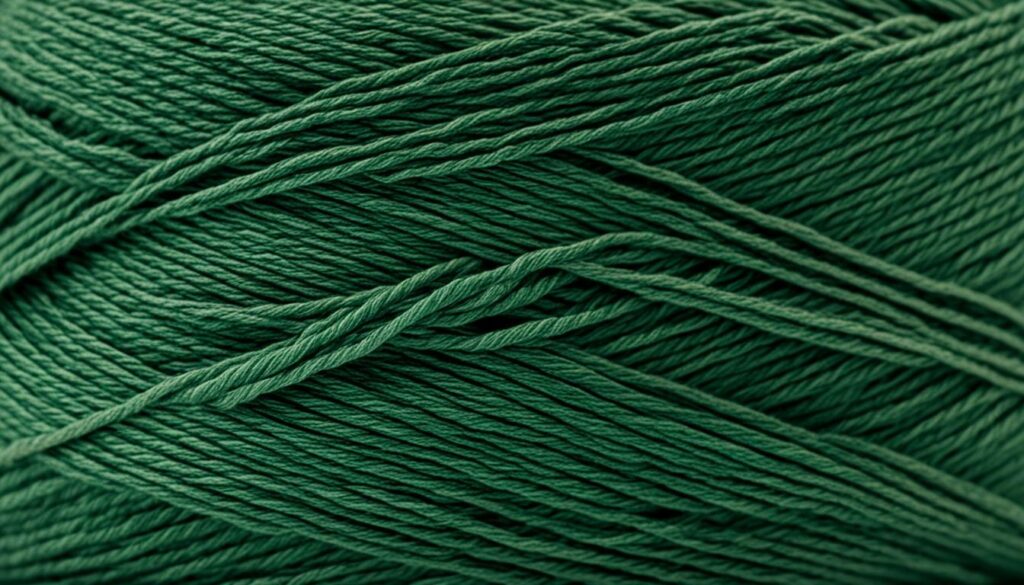
Exploring Popular Needlepoint Yarns and Threads
When it comes to needlepoint projects, choosing the right yarn is essential for creating beautiful and long-lasting designs. There are several popular needlepoint yarns and threads available, each with its own unique characteristics and benefits. Let’s explore some of these options:
Persian Yarn
Persian yarn is an all-purpose, 3-strand wool yarn that is widely used in the needlepoint community. It can easily be separated or combined to achieve the desired thickness. The versatility of Persian yarn makes it a popular choice for a wide range of needlepoint projects.
Tapestry Yarn
Tapestry yarn is a single-strand yarn available in both wool and acrylic options. It is slightly finer than Persian yarn, making it ideal for creating intricate details and fine lines in your needlepoint designs. Tapestry yarn is a great choice for adding depth and texture to your projects.
Crewel Yarn
Crewel yarn is a fine single-strand yarn spun from wool or acrylic fibers. It is commonly used in crewel embroidery but can also be used in needlepoint projects. Crewel yarn is known for its softness and ability to create delicate stitches, making it perfect for adding subtle accents and details to your needlepoint designs.
Embroidery Floss
Embroidery floss is a multiple-strand thread that is available in cotton, rayon, or silk. It is a versatile thread that can be used for various embroidery techniques, including needlepoint. Embroidery floss allows you to create vibrant and colorful designs, and its multiple strands offer versatility in thickness and coverage.
Pearl Cotton
Pearl cotton is a lustrous, single-strand cotton thread that is commonly used in various needlework crafts, including needlepoint. It has a smooth texture and is available in different thicknesses. Pearl cotton creates beautiful stitches and adds a subtle sheen to your needlepoint designs.
Matte Embroidery Cotton
Matte embroidery cotton is a soft, single-strand cotton thread with a dull finish. It is commonly used in hand embroidery and can also be used in needlepoint. Matte embroidery cotton adds a unique texture and visual interest to your needlepoint projects, giving them a more rustic and vintage look.
Metallic Thread
Metallic thread is available in various weights, colors, and textures, and it is often used for highlighting small areas or adding a touch of sparkle to your needlepoint designs. Metallic thread can create a stunning visual impact and bring your designs to life with its shimmer and shine.
Each of these popular needlepoint yarns and threads provides its own unique qualities, allowing you to create diverse and stunning needlepoint designs. Experimenting with different yarns and threads will help you discover new techniques and unleash your creativity in your needlepoint projects.
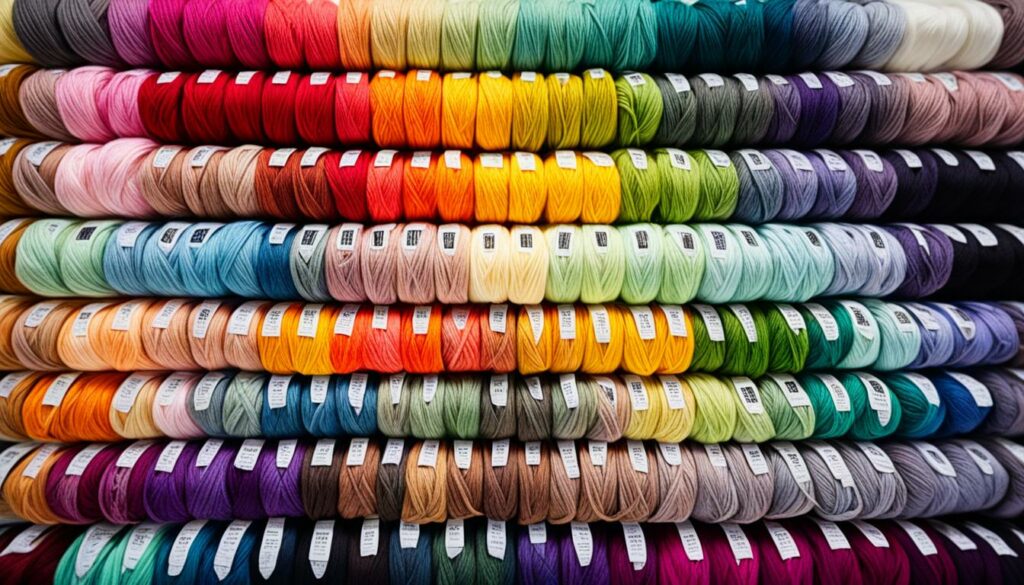
Here is a table summarizing the key features of these popular needlepoint yarns and threads:
| Yarn/Thread | Fiber | Thickness | Texture | Recommended Use |
|---|---|---|---|---|
| Persian Yarn | Wool | Medium | Smooth | Versatile, all-purpose yarn |
| Tapestry Yarn | Wool or Acrylic | Fine | Soft | Detail work, fine lines |
| Crewel Yarn | Wool or Acrylic | Fine | Soft | Delicate accents, details |
| Embroidery Floss | Cotton, Rayon, or Silk | Multiple strands | Varies | Colorful designs, versatility |
| Pearl Cotton | Cotton | Varies | Lustrous | Smooth stitches, subtle sheen |
| Matte Embroidery Cotton | Cotton | Fine | Dull | Rustic, vintage look |
| Metallic Thread | Metallic | Varies | Shimmer, shine | Highlighting small areas, sparkle |
With these popular needlepoint yarns and threads at your disposal, you can unleash your creativity and create stunning needlepoint designs. The choice of yarn and thread depends on the desired effect, texture, and overall look you want to achieve in your needlepoint projects.
Matching Yarn to the Canvas Type
The choice of yarn plays a vital role in needlepoint projects, and it should be carefully selected to match the type of canvas being used. Whether you’re working with mono canvas, double-thread canvas, interlock canvas, or plastic canvas, there are specific yarn options that work best for each type.
Mono Canvas
Mono canvas, also known as single-thread canvas, is a versatile option suitable for a variety of needlepoint stitches. When working on a mono canvas, you have the flexibility to choose from various yarns. This canvas type allows for stitching with a combination of yarn types, including yarn for mono canvas.
Double-Thread Canvas
Double-thread canvas, also known as Penelope canvas, is woven with double threads, which makes it strong enough to handle all types of needlepoint stitches, including petit point. For double-thread canvas, it is best to use yarn for double-thread canvas to ensure the stitches are secure and the design is well-defined.
Interlock Canvas
Interlock canvas features interlocking horizontal and vertical threads, making it lightweight and suitable for smaller, framed projects. Due to its delicate nature, it pairs well with yarn for interlock canvas to ensure the stitches glide through the mesh effortlessly, resulting in a smooth and even design.
Plastic Canvas
Plastic canvas is available in various shapes and sizes, and it offers flexibility and sturdiness. It is often used for functional items and unfinished edge projects. When stitching on plastic canvas, it is essential to choose yarn for plastic canvas, which ensures the stitches securely adhere to the plastic material, creating durable and functional needlepoint pieces.
By selecting the appropriate yarn and canvas match, you can ensure that your needlepoint projects turn out beautifully and withstand the test of time.
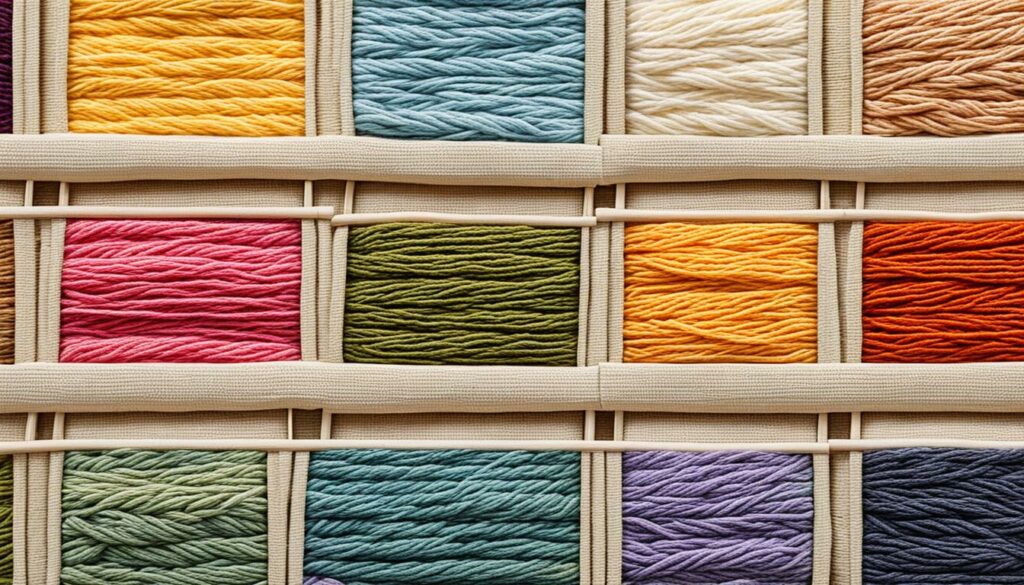
Considering the Final Result
When choosing the yarn for your needlepoint project, it’s important to consider the final result you want to achieve. The choice of yarn should be based on whether you are creating a functional or decorative item.
If your needlepoint project is intended for functional use, such as couch cushions or chair seats, it’s recommended to use a durable and heavy-duty yarn. Wool is an excellent choice for these types of items as it is naturally strong and can withstand regular use. Wool yarn provides both durability and comfort, ensuring that your functional needlepoint items will last for a long time.
On the other hand, if you are creating a decorative piece, you may opt for thinner yarn or thread for embellishment purposes. Decorative needlepoint items, such as wall hangings or framed art, often require intricate details and delicate finishing touches. Thin yarn or thread can add a touch of elegance to your designs without overpowering them.
Consider the intended use of your needlepoint project and select the yarn accordingly. Functional items call for durable and heavy-duty yarn, while decorative pieces offer more flexibility in terms of yarn options. By choosing the right yarn for your needlepoint project, you can ensure that the final result meets your expectations in terms of both durability and aesthetic appeal.
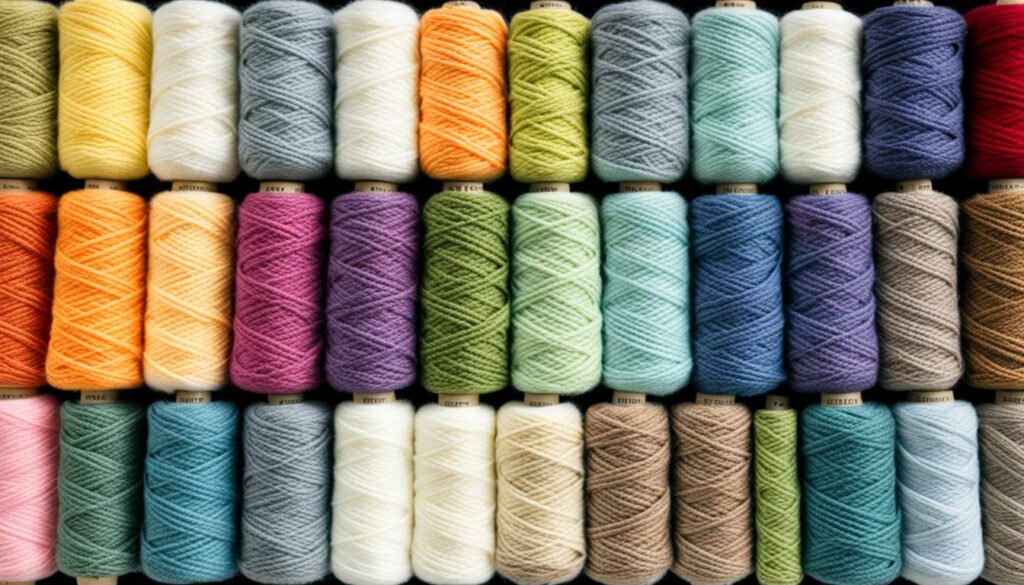
| Functional Needlepoint Items | Decorative Needlepoint Items | |
|---|---|---|
| Recommended Yarn | Heavy-duty yarn such as wool | Thin yarn or thread for embellishment |
| Main Features | Durability and comfort | Intricate details and delicate finishing touches |
| Examples | Couch cushions, chair seats | Wall hangings, framed art |
Other Factors to Consider
In addition to yarn weight, thickness, and fiber, there are other factors that should be taken into account when choosing the perfect yarn for your needlepoint project. These factors include texture and color, which can greatly influence the overall aesthetic and impact of your finished piece.
Considering Needlepoint Yarn Texture
The choice of yarn texture can significantly contribute to the visual appeal and feel of your needlepoint artwork. Wool, cotton, and silk threads are versatile options that can create classic and traditional designs. Their smooth texture allows for even and consistent stitches, resulting in a polished look. Moreover, the different fibers offer unique qualities; wool provides warmth and resilience, cotton offers a smooth finish, and silk imparts a luxurious shine.
On the other hand, novelty threads can add an exciting touch to your needlepoint. These threads often have unique textures, such as metallic or fuzzy textures, that can introduce dimension and sparkle to your canvas. However, it is important to use novelty threads sparingly to maintain a balanced and harmonious composition. Overusing novelty threads may overwhelm the design and distract from the overall aesthetic of your needlepoint artwork.
Exploring Needlepoint Yarn Color
When considering yarn color for your needlepoint project, there are two main approaches you can take. The first approach involves matching the colors of the threads to the pre-painted canvas. By doing so, you can achieve a seamless integration between the threads and the canvas design, resulting in a cohesive and unified composition. This approach is particularly suitable for needlepoint kits or projects that aim to reproduce a specific image or pattern.
Alternatively, you may choose to select yarn colors that complement the design of the canvas without precisely matching them. This approach allows for more creative freedom and personalization, as you can adjust the colors of the canvas to suit your preferences and decor. By opting for complementary colors, you can create contrast and visual interest within your needlepoint artwork.
Remember, the chosen yarn color can significantly influence the overall mood and impact of your needlepoint piece. Bright and bold colors can create a vibrant and energetic atmosphere, while softer and pastel shades can evoke a sense of calm and tranquility.
Ultimately, the selection of yarn texture and color should align with your artistic vision and the intended style of your needlepoint project. Consider the visual and tactile effect you want to achieve, and experiment with different combinations to create a truly unique and captivating piece of needlework.
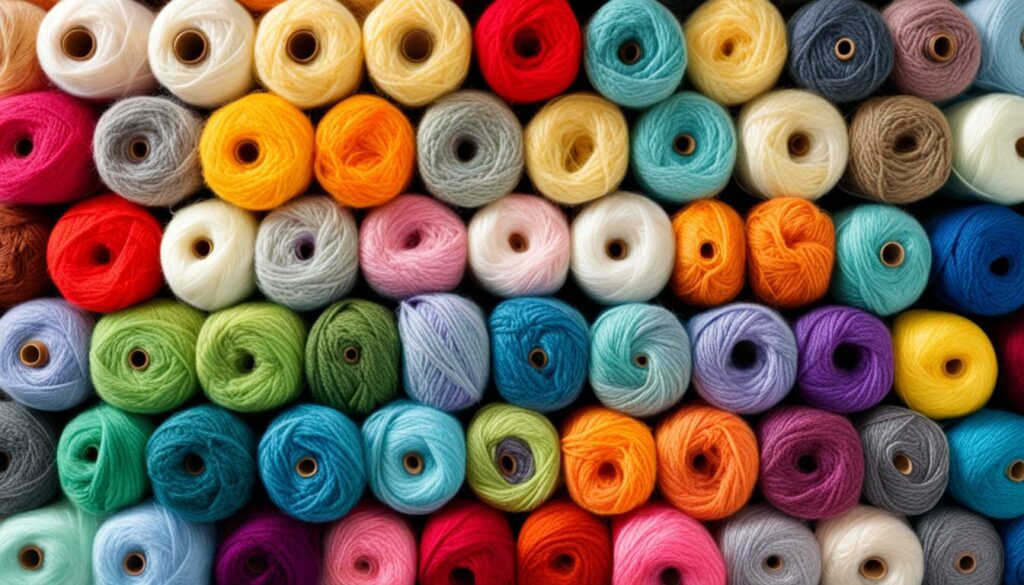
| Yarn Considerations | Texture | Color |
|---|---|---|
| Wool, Cotton, Silk | Smooth, Versatile | Complementary, Harmonious |
| Novelty Threads | Unique, Textured | Accent, Sparkle |
Understanding Canvas Types
When it comes to needlepoint, choosing the right canvas is just as important as selecting the perfect yarn. There are several types of needlepoint canvases to consider, each with its own characteristics and uses.
Mono Canvas
Mono canvas, also known as single-thread canvas, is a popular choice for beginners and experienced stitchers alike. It is made from a single thread per mesh and is suitable for a variety of needlepoint stitches. The even weave of mono canvas makes it easy to create smooth and precise designs. It is available in different mesh sizes to accommodate different yarn thicknesses.
Double-Thread Canvas
Double-thread canvas, sometimes referred to as Penelope canvas, is woven with double threads per mesh. This type of canvas can be used for all needlepoint stitches, including petit point. The double threads provide added strength and stability to the canvas, making it suitable for intricate and detailed designs.
Interlock Canvas
Interlock canvas is a lightweight option that is ideal for smaller, framed projects. It features interlocking horizontal and vertical threads, which create a secure foundation for stitching. Interlock canvas is often used for needlepoint designs that will be displayed as artwork or small decorative pieces.
Plastic Canvas
Plastic canvas is a versatile option that comes in different shapes and sizes. It is made from a flexible and sturdy plastic material. Plastic canvas is commonly used for functional needlepoint items such as coasters, tissue box covers, and ornaments. It is also a suitable choice for projects with unfinished edges, as it provides stability and structure.
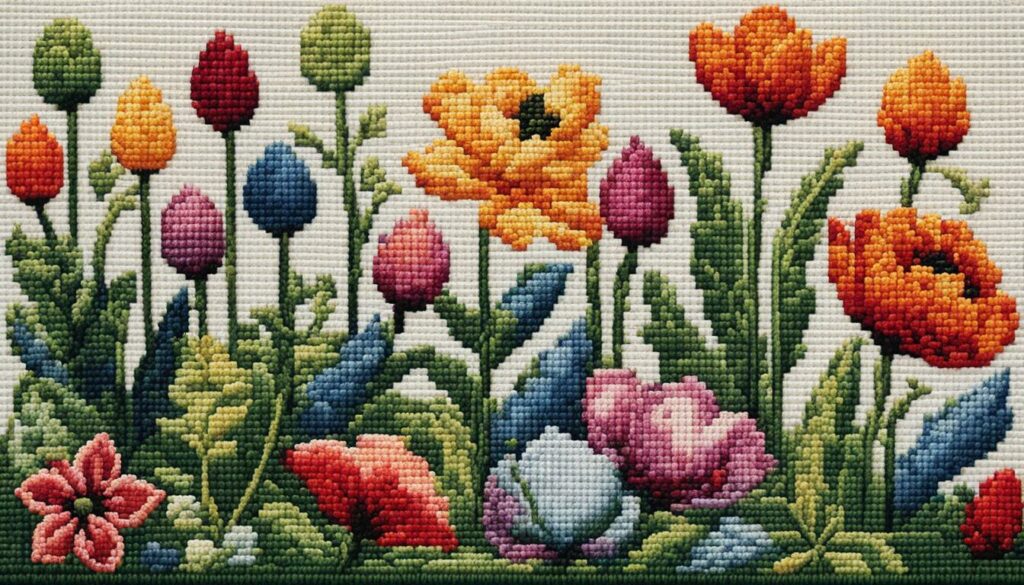
Now that we’ve explored the different types of needlepoint canvases, you can select the one that best suits your project. Consider the level of detail, the size of the design, and the intended use to make an informed decision. The right canvas, combined with the perfect yarn, will ensure a beautiful and long-lasting needlepoint creation.
Matching Yarn to Canvas Mesh Count
When it comes to needlepoint, the mesh count of the canvas plays a crucial role in determining the number of holes or stitches per square inch. To create a beautiful and well-balanced design, it’s essential to match the yarn to the mesh size. Let’s explore the factors to consider for selecting the right yarn based on the canvas mesh count.
Smaller mesh count requires smaller threads, while larger mesh count calls for thicker threads.
The weight and thickness of the yarn play a significant role in achieving the desired result. For smaller mesh counts, such as 14 or 18, it’s best to use thinner threads to ensure they glide smoothly through the holes without tugging or causing gaps in the design. Fine yarns like crewel embroidery wool or embroidery floss are suitable choices for these mesh sizes.
On the other hand, when working with larger mesh counts like 10 or 12, thicker threads are recommended to ensure full coverage and a sturdy final result. Yarns such as Persian wool or tapestry yarn, which have a thicker weight, are well-suited for larger mesh counts.
It’s important to note that certain novelty threads, with their unique textures, may create drag when pulled through the holes of the canvas. To avoid any issues, it’s a good practice to conduct a small test by stitching a sample area before using novelty threads extensively on a particular piece.
Yarn Selection Based on Mesh Count
| Mesh Count | Recommended Yarn |
|---|---|
| 14 or 18 | Crewel embroidery wool |
| 14 or 18 | Embroidery floss |
| 10 or 12 | Persian wool |
| 10 or 12 | Tapestry yarn |
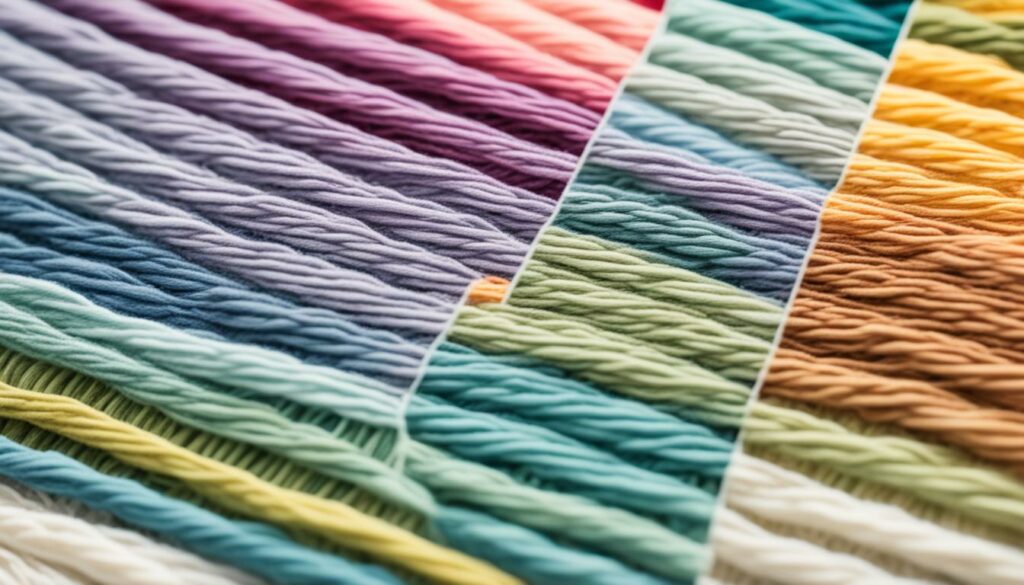
By considering the mesh count of the needlepoint canvas and selecting the appropriate yarn, you can ensure a smooth stitching process and achieve a beautiful finished piece. Experiment with different yarns to find the perfect match for your next needlepoint project!
Considering Texture in Needlepoint
The texture of the yarn used in needlepoint can greatly impact the final result. When creating a classic, traditional aesthetic, consider using wool, cotton, or silk threads throughout the entire canvas. These fibers offer a smooth and luxurious texture that complements various needlepoint designs. Threads made from these natural fibers provide a soft and comforting feel as you work on your project.
In contrast, novelty threads can add an exciting dimension to your needlepoint piece. These threads often have unique textures, such as metallic or chenille, that create visual interest and sparkle. However, it’s important to use novelty threads sparingly, as their bold texture can easily overwhelm the overall design. Incorporate them strategically to highlight specific areas or elements of your needlepoint.
When selecting a thread texture, consider the design element you are stitching. For example, if your needlepoint features a flower, using a thread with a texture resembling petals can enhance the realism and make your artwork come alive. Mimicking textures in this way creates a cohesive and aesthetically pleasing outcome.
Quotes:
“The right texture can bring a needlepoint piece to life, adding depth and visual interest.” – Expert Needlepointer
“Novelty threads can be a fun and whimsical addition to any needlepoint project, but be cautious not to overshadow the overall design.” – Needlecraft Enthusiast
Using Novelty Threads in Needlepoint:
Novelty threads offer an expansive array of unique textures to elevate your needlepoint artistry. Consider incorporating these threads to:
- Add sparkle and shine to accent areas
- Create texture and depth in specific elements
- Emphasize important design features
Novelty Threads Suggestions:
| Thread Type | Texture | Usage |
|---|---|---|
| Metallic Thread | Shimmering | Highlight small areas, add sparkle |
| Chenille Thread | Soft and fuzzy | Create plush textures, enhance dimension |
| Ribbon Thread | Flat and glossy | Embellish decorative elements, create smooth accents |
Adding the right texture to your needlepoint piece can make it truly stand out. Whether you choose the elegance of natural fibers or the excitement of novelty threads, consider how the texture can enhance your design. By selecting the appropriate thread texture and incorporating it thoughtfully, you’ll bring depth, personality, and beauty to your needlepoint creations.
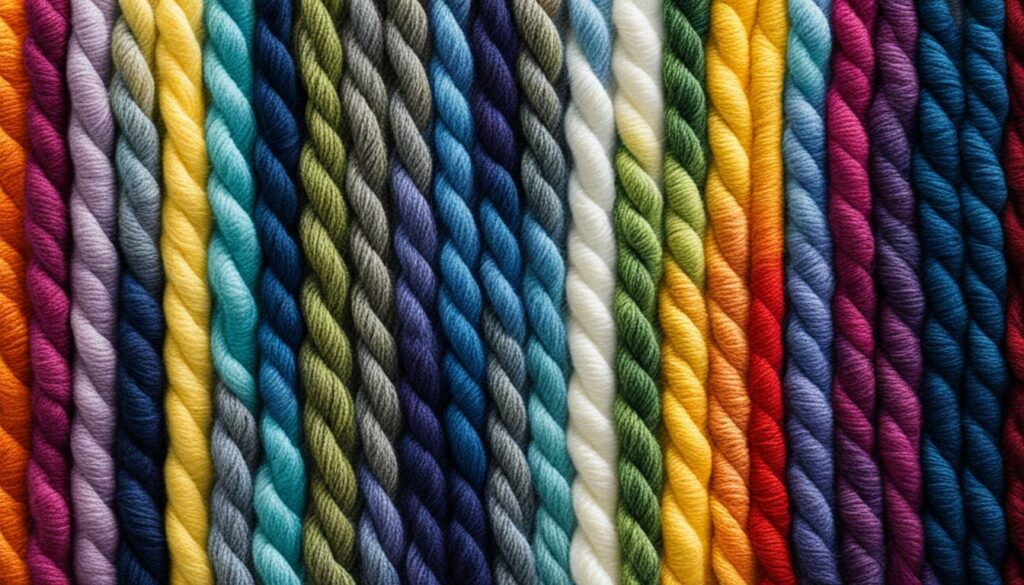
Conclusion
In conclusion, choosing the right yarn for your needlepoint project is essential to achieve a successful and visually appealing result. When making your yarn selection, consider various factors such as the weight, thickness, fiber, durability, canvas type, intended use, color, and texture. Persian yarn, tapestry yarn, crewel yarn, embroidery floss, pearl cotton, matte embroidery cotton, and metallic thread are all excellent options to explore.
By experimenting with different yarn choices, you can find the perfect match that will bring your needlepoint projects to life. Remember to match the yarn’s weight and thickness to the gauge of the canvas, select a fiber that suits the project’s durability needs, and choose colors and textures that complement the design. Whether you’re creating functional items or decorative pieces, there is a yarn out there that will meet your specific requirements.
So, grab your needles and start stitching with confidence knowing that you’ve considered all the important aspects of needlepoint yarn selection. Happy stitching!
